Mario + Rabbids Kingdom Battle (Nintendo Switch) Review
By Rudy Lavaux  04.09.2017
04.09.2017

It's easy to imagine the surprise of people when it was announced back in the early 1990s that Mario would star in a game about racing on go-karts, or even that Mario would star in his very own RPG developed by none other than SquareSoft, then an absolute king of JRPG. The early leak of Mario featuring in what was then said to be a crossover RPG with Ubisoft's Rabbids sure raised some eyebrows. It would be hard to imagine two such dissimilar franchises working together and, most importantly, Nintendo of all companies allowing that to happen, relegating the leak perhaps to the ranks of fake news. Lo and behold, though, it turned out to be true, for the most part! Not an RPG but an XCOM-style turn-based strategy adventure with mild puzzle elements, Mario + Rabbids: Kingdom Battle is very real, and now it's out on the market. After Cubed3's early hands-on and the pre-release video impressions, the team got to experience much of the title to deliver readers the final judgement.
An unnamed young woman, who is a huge fan of all things Mario and apparently a talented engineer, creates an augmented reality headset called the Supamerge, which allows the wearer to fuse two things together to make a completely new one. In come the Rabbids in what appears to be a time/alternate reality-travelling washing machine (with a nice reference to Back to the Future thrown in for good measure) who start messing up the lab and stumble upon said headset, which in their usual messing around with things merges some Rabbids with Nintendo figurines, creating Rabbid Peach, Rabbid Luigi and so on... but also sends them to the Mushroom Kingdom when the headset hits the Washing Machine. The effects of the headset gone haywire turn the kingdom upside down, mixing it with lots of Rabbid elements. It is, therefore, up to Mario and the gang to stop the Rabbid wearing the headset before it does more damage as the Supamerge seems to be the only way to turn everything back to normal.
The Mushroom Kingdom, though, is now full of Rabbids turned... rabid by the Supamerge, so going after the little critter will be no easy task as Mario and friends, helped by the Rabbid fusions of Rabbid Peach and the like, have to face them in turn-based battles, hiding behind cover and using a wide variety of weapons and special kills to help them get the upper-hand against their opponents. The party of playable characters is led by the augmented reality assistant Beep-O who teaches how to play but who also is constantly leading the party through the vast world on offer. These are the basic premise and concept behind Mario + Rabbids Kingdom Battle. Along the way, Mario and company's skill-set and arsenal improve as more challenges are taken, more battles are fought and, most importantly, as more treasure chests scattered about the Mushroom Kingdom are discovered and opened. There is indeed an important element of exploration to the game, although most areas play in a fairly linear fashion. Each of the several environments (the usual mix of forest, desert, lava, and so on...) is divided into numbered sub-chapters, (like 1-2, 2-5, and so on) and these are played in order, so the environment is built in such a way that gamers must explore the world in order, but some back-tracking will still be required because certain optional areas can be found blocked by certain things that cannot be moved until later, for example. In such cases, Beep-O will typically learn whatever technique is required to move forward (pushing a block, getting dirt out of the way…) at the end of a full chapter, which means that exploration really can't be done in any order chosen.
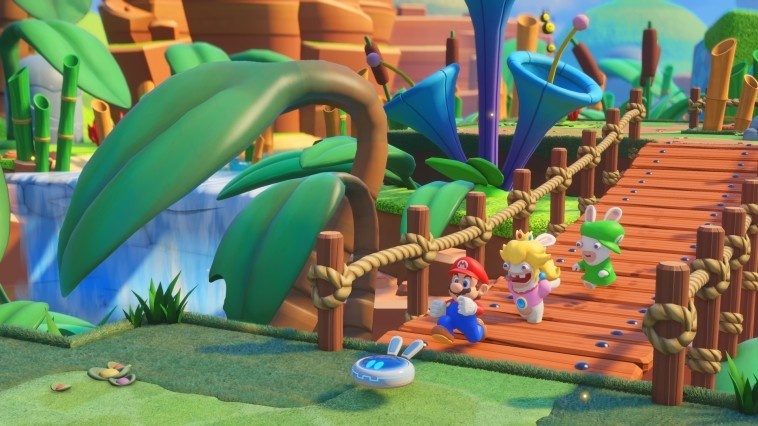
This element of linearity comes as a slight disappointment, but is understandable all the same, given the type of game that it is, and other games in the same genre use a similar approach in general. Conversely, this linearity is applied in the presentation, as well, where the player can only rotate the camera left or right in and outside of battle, and not up or down, which limits the field of view only to the party's immediate vicinity and prevents from getting a glimpse at what awaits in the far distance. While this kind of limits the appreciation of the fantastic world that lies ahead, this also means that what awaits is kept a surprise until the very last moment, so there's both good and bad in this approach, although in those rare occurrences where the camera does pan closer to the ground to show what's coming, the game's limitations show drastically as the draw distance on display is relatively short indeed and the engine never renders much more than what is necessary outside the boundaries of what the player normally is able to see and, for the record, there doesn't seem to be any difference in draw distance between the docked and handheld mode.
Mario + Rabbids Kingdom Battle is not a game that's very impressive on a pure technical level, running only at 900p30 natively in docked mode with some light, short freezes experienced at times (caught on video during the hands-on demonstration) and some slowdown and stutter experienced in handheld mode, as well, during big close-ups on big attacks in battle... however... it is still a decidedly pretty game to look at, without any big technical bells and whistles, and it's all thanks to an excellent art direction. Sure, the polygons show a lot on the Rabbids' character models, but the world itself and the animation of the characters on display are used for such a huge comical effect that any gripes with the technical imperfections are quickly forgiven and forgotten, especially with such an excellent soundtrack by Grant Kirkhope to accompany all of this. These qualities pulling players in quickly leave the focus to be on the gameplay itself - the core of the experience: the battles.
In pure XCOM fashion, and especially Shadowrun Returns, which used a similar battle system, each team takes turns to perform different types of action: movement, attack, bouncing off of a team partner, and dashing into an enemy unit while on the move. The first immediately noticeable great thing about this is that, contrary to a strategy RPG like Fire Emblem, these actions can be performed in just about in order and not necessarily all in immediate succession.
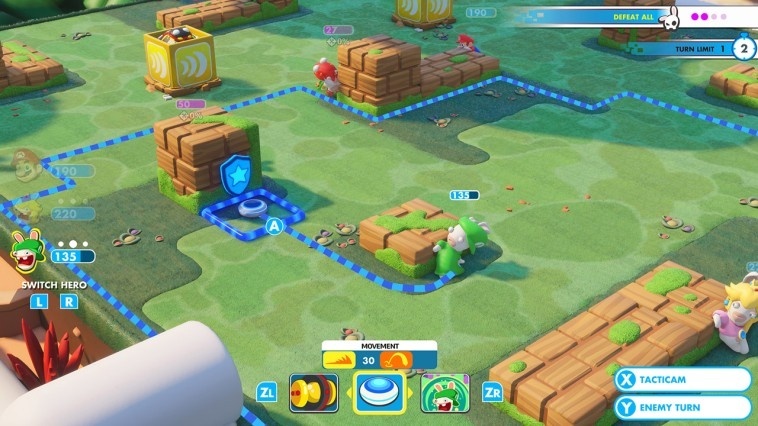
A player is free to have Mario shoot an enemy unit, then shift to Rabbid Peach and have her dash into an enemy and run for cover, and then go back to Mario and move him afterwards, then back to Rabbid Luigi, and so on. The party's turn only truly ends when everyone is done doing all that they could, in no specific order, unless the player chooses for strategic reasons to not perform all possible actions on the spot, which is something that will often happen. What can't be done, however, is changing weapons mid-battle. The party's equipment and line-up (of up to three playable characters maximum) has to be decided in the Battle HQ before each battle, and the battle HQ only unlocks after a few sub-chapters have been played.
Battles themselves are kept very simple during those early stages, just to teach the player the basics of the gameplay, but, soon after, things shift gear and become a lot more challenging very quickly, which can and potentially will take some players by surprise, especially newcomers to the genre who were attracted by the colourful, kiddie looking world chock-full of references to not just Mario and Rabbids, but also pop culture stuff making for the humorous situations that give this game its devastatingly attractive charm. Although the game itself doesn't put a lot of emphasis on this as soon as it becomes possible to do so, changing equipment, line-up, and also potentially skills, will be very important to adapt to every situation. While it's okay to not bother with this early on, it becomes a constant necessity soon after and perhaps this should have been better explained.
However, the most proud of players will prefer to stick with the normal mode at all times, where HP only recovers in-between sub-chapters or upon collecting a mushroom during exploration phases. To get a permanent HP upgrade, chapters must be completed or skill points obtained to invest in each of the playable character's skill tree. Such points can either be obtained in treasure chests, over the normal course of the story, or by completing challenges that pop up in previously explored areas when a chapter is completed.
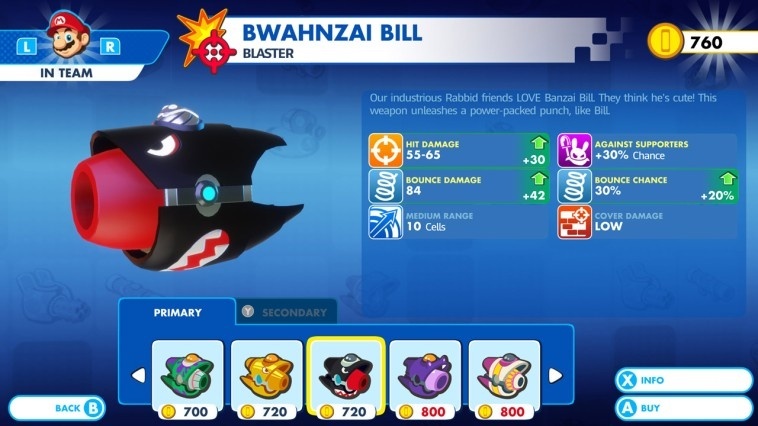
At launch, resetting the skill tree cost coins, but since then, as of the writing of this review anyway, an update was brought out that makes this completely free, leaving players free to explore the strategic possibilities offered by different allocations of skill points for each character to their heart's content and, in games such as this one, more freedom is always welcomed! Coins are, therefore, now only spent on buying new main or sub weapons. Said weapons are added to the Battle HQ shop as they are found inside treasure chests or they may unlock upon completing a chapter. Weapons can have varying degrees of efficiency against different types of enemies, may induce a status change, such as honey that prevents a unit from moving from their current location (but not from shooting at the player), and so on, and so forth.
There is as much depth to Mario + Rabbids Kingdom Battle as would be expected from this particular genre. Just because it's Mario and Rabbids, it looks like it appeals to a younger audience and it's also hilarious, but that doesn't mean that it's not deep and challenging, and this is probably something that must be insisted upon to doubters out there. Newcomers to the genre, or people allergic to it, should probably use caution, such as trying the game out at a friend's if possible at all. The best option would, of course, be if Ubisoft made a demo for the eShop that exposed the early tutorial battles and a later portion showing off the average difficulty that can be expected, so as to avoid potential frustration after purchase. It's a strategy game through and through, even if it is a Mario one, and the level of difficulty is perhaps just a bit higher than might be expected as a result of its lead character but, then again, the genre itself dictates that. An easy strategy game wouldn't be a strategy game at all, and even then, there are certainly more challenging ones out there than this, so although this had to be pointed out, it's not a knock against it at all when all is said and done.
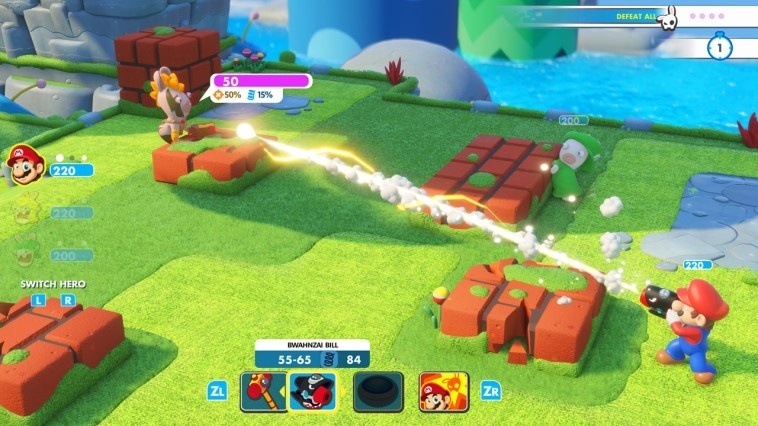
Cubed3 Rating
Great - Silver Award

Mario + Rabbids Kingdom Battle is a hilarious, fun, and attractive looking title, despite some technical flaws here and there that are quickly overlooked due to all of its intrinsic qualities. If anything, this is perhaps the one Rabbid game that will truly push the critters into the realm of mainstream on a worldwide level, more so than they have ever been so far, simply because they are such a perfect fit with Mario in that universe, in a way that nobody would have ever expected. It's challenging, for sure, so fans of Mario who are wary of strategy games beware. If even ever so slightly interested in strategy, though, and willing to sit through it all, persevering as much as it takes to see it through to the end is a complete blast. Well worth checking out.
Comments
Comments are currently disabled

 Sign In
Sign In Game Details
Game Details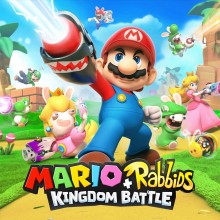
 Out now
Out now  Out now
Out now  Out now
Out now  Out now
Out now  Subscribe to this topic
Subscribe to this topic Features
Features





 Top
Top

